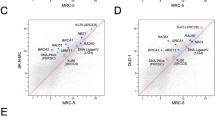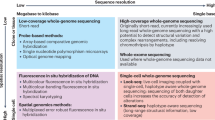Abstract
Interstitial deletions of the chromosome 9p21 segment encoding the p16/CDKN2A tumor suppressor gene (i.e., 9p21 deletions) are frequently observed in a variety of human cancers. A majority of these deletions in lymphoid leukemia have been indicated to be mediated by illegitimate V(D)J recombination. In the present study, to elucidate the molecular processes of 9p21 deletions in nonlymphocytic malignancies, breakpoints for these deletions were analysed in 21 lung cancer cell lines and 32 nonlymphocytic cancer cell lines of nine other histological types. In all, 32 breakpoints in 21 lung cancer cell lines and 56 breakpoints in 32 nonlung cancer cell lines were mapped in a 450-kb segment encompassing the CDKN2A locus with a 10-kb resolution. The largest number of breakpoints (i.e., seven breakpoints in lung cancer and 12 breakpoints in nonlung cancers) was mapped in a 10-kb region containing the CDKN2A gene. More precise mapping of these seven and 12 breakpoints revealed that none of these breakpoints were located within 50-bp intervals to each other in this 10 kb region. Cloning and sequencing of breakpoints in 18 representative cell lines (six lung and 12 nonlung cancers) further revealed that there were no significant homologies among breakpoints in these 18 cell lines. In 11 (61%) cell lines, 1–5-bp nucleotides were overlapped at breakpoint junctions. These results indicate that DNA double-strand breaks triggering 9p21 deletions do not occur at specific DNA sequences, although they preferentially occur in or near the CDKN2A locus. It was also indicated that two broken DNA ends are rejoined by nonhomologous end-joining repair, preferentially utilizing microhomologies of DNA ends, in the occurrence of 9p21 deletions.
This is a preview of subscription content, access via your institution
Access options
Subscribe to this journal
Receive 50 print issues and online access
$259.00 per year
only $5.18 per issue
Buy this article
- Purchase on Springer Link
- Instant access to full article PDF
Prices may be subject to local taxes which are calculated during checkout


Similar content being viewed by others
References
Canning S and Dryja TP . (1989). Proc. Natl. Acad. Sci. USA, 86, 5044–5048.
Cayuela JM, Gardie B and Sigaux F . (1997). Blood, 90, 3720–3726.
Drexler HG . (1998). Leukemia, 12, 845–859.
Hamada K, Kohno T, Kawanishi M, Ohwada S and Yokota J . (1998). Genes Chromosom. Cancer, 22, 232–240.
Hamada K, Kohno T, Takahashi M, Yamazaki M, Tashiro H, Sugawara C, Ohwada S, Sekido Y, Minna JD and Yokota J . (2000). Genes Chromosom. Cancer, 27, 308–318.
Hoeijmakers JH . (2001). Nature, 411, 366–374.
Inoue H, Ishii H, Alder H, Snyder E, Druck T, Huebner K and Croce CM . (1997). Proc. Natl. Acad. Sci. USA, 94, 14584–14549.
Jasin M . (2000). Cancer Invest., 18, 78–86.
Kamb A, Gruis NA, Weaver-Feldhaus J, Liu Q, Harshman K, Tavtigian SV, Stockert E, Day RS, Johnson BE and Skolnick MH . (1994). Science, 264, 436–440.
Kitagawa Y, Inoue K, Sasaki S, Hayashi Y, Matsuo Y, Lieber MR, Mizoguchi H, Yokota J and Kohno T . (2002). J. Biol. Chem., 277, 46289–46297.
Kohno T, Otsuka T, Inazawa J, Abe T and Yokota J . (1996). DNA Res., 3, 421–424.
Lewis SM . (1994). Adv. Immunol., 56, 27–150.
Lieber MR . (1999). Genes Cells, 4, 77–85.
Mimori K, Druck T, Inoue H, Alder H, Berk L, Mori M, Huebner K and Croce CM . (1999). Proc Natl. Acad. Sci. USA, 96, 7456–7461.
Nishioka M, Kohno T, Takahashi M, Niki T, Yamada T, Sone S and Yokota J . (2000). Oncogene, 19, 6251–6260.
Nobori T, Miura K, Wu DJ, Lois A, Takabayashi K and Carson DA . (1994). Nature, 368, 753–756.
Ochman H, Gerber A S and Hartl DL . (1988). Genetics, 120, 621–623.
Ohnishi H, Kawamura M, Ida K, Sheng XM, Hanada R, Nobori T, Yamamori S and Hayashi Y . (1995). Blood, 86, 1269–1275.
Park M, Shimizu K, Nakano T, Park YB, Kohno T and Yokota J . (2002). Cancer Genet. Cytogenet., 141, 5–13.
Pomykala HM, Bohlander SK, Broeker PL, Olopade OI and Diaz MO . (1994). Mol. Cell. Biol., 14, 7604–7610.
Roth DB and Wilson JH . (1986). Mol Cell Biol., 6, 4295–4304.
Sanchez-Cespedes M, Ahrendt SA, Piantadosi S, Resell R, Monzo M, Wu L, Westra WH, Yang SC, Jen J and Sidransky D . (2001). Cancer Res., 61, 1309–1313.
Sekido Y, Ahmadian M, Wistuba II, Latif F, Bader S, Wei MH, Duh FM, Gazdar AF, Lerman MI and Minna JD . (1998). Oncogene, 16, 3151–3157.
Sherr CJ . (2000). Cancer Res., 60, 3689–3695.
Smerdon MJ and Conconi A . (1999). Prog. Nucleic Acid Res. Mol. Biol., 62, 227–255.
Smith J, Baldeyron C, De Oliveira I, Sala-Trepat M and Papadopoulo D . (2001). Nucleic. Acids Res., 29, 4783–4792.
Tanaka H, Shimada Y, Imamura M, Shibagaki I and Ishizaki K . (1997). Int. J. Cancer, 70, 437–442.
Tremblay A, Jasin M and Chartrand P . (2000). Mol. Cell. Biol., 20, 54–60.
Wistuba II, Lam S, Behrens C, Virmani AK, Fong KM, LeRiche J, Samet JM, Srivastava S, Minna JD and Gazdar AF . (1997). J. Natl. Cancer Inst., 89, 1366–1373.
Acknowledgements
This study was supported in part by Grants-in-Aid from the Ministry of Education, Culture, Sports, Science and Technology of Japan for Scientific Research on Priority Areas (KAKENHI 14026064), the Program for Promotion of Fundamental Studies in Health Sciences of the Organization for Pharmaceutical Safety and Research of Japan, the Ministry of Health, Labour and Welfare of Japan for the 2nd-term Comprehensive 10-Year Strategy for Cancer Control, and National Cancer Institute Specialized Programs of Research Excellence Grant P50 CA70907, and the Foundation for Promotion of Cancer Research. We thank the following scientists for providing us cell lines: Drs WK Cavenee, IJ Fidler, AF Gazdar, Y Hayata, S Naito, M Oshimura, T Sekine, Y Shimada, M Takada, M Terada, N de Tribolet and M Yoshida. Cell lines were also obtained from the American Type Culture Collection, the Japan Cell Resource Bank and the Institute for Fermentation, Osaka, Japan. We also thank Ms M Takahashi for technical assistance.
Author information
Authors and Affiliations
Corresponding author
Rights and permissions
About this article
Cite this article
Sasaki, S., Kitagawa, Y., Sekido, Y. et al. Molecular processes of chromosome 9p21 deletions in human cancers. Oncogene 22, 3792–3798 (2003). https://doi.org/10.1038/sj.onc.1206589
Received:
Revised:
Accepted:
Published:
Issue Date:
DOI: https://doi.org/10.1038/sj.onc.1206589
Keywords
This article is cited by
-
PLAA suppresses ovarian cancer metastasis via METTL3-mediated m6A modification of TRPC3 mRNA
Oncogene (2022)
-
Genomic consequences of aberrant DNA repair mechanisms stratify ovarian cancer histotypes
Nature Genetics (2017)
-
MicroRNA-31 modulates tumour sensitivity to radiation in oesophageal adenocarcinoma
Journal of Molecular Medicine (2012)
-
Different molecular mechanisms causing 9p21 deletions in acute lymphoblastic leukemia of childhood
Human Genetics (2009)
-
Unbalanced translocation, a major chromosome alteration causing loss of heterozygosity in human lung cancer
Oncogene (2008)



